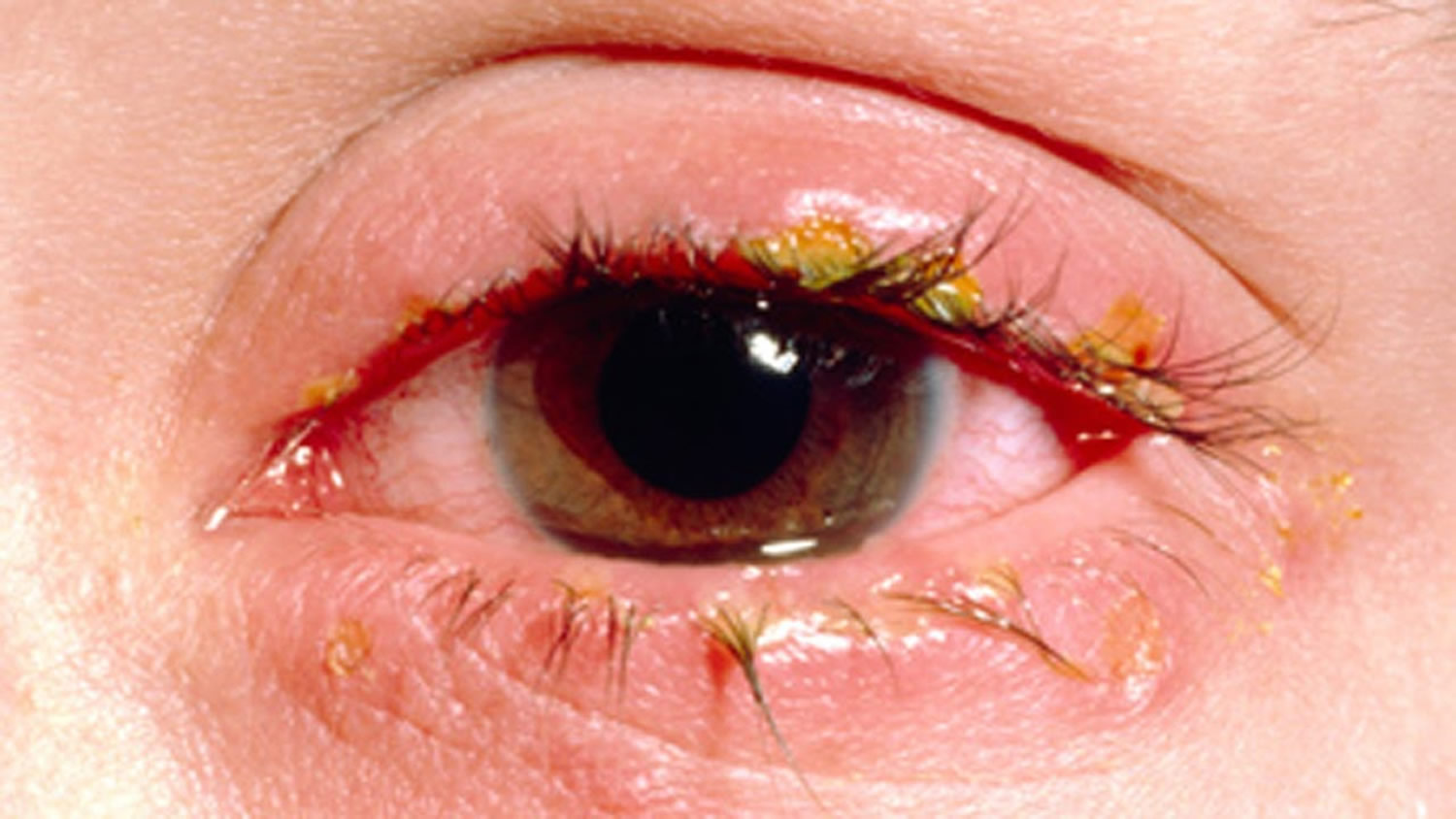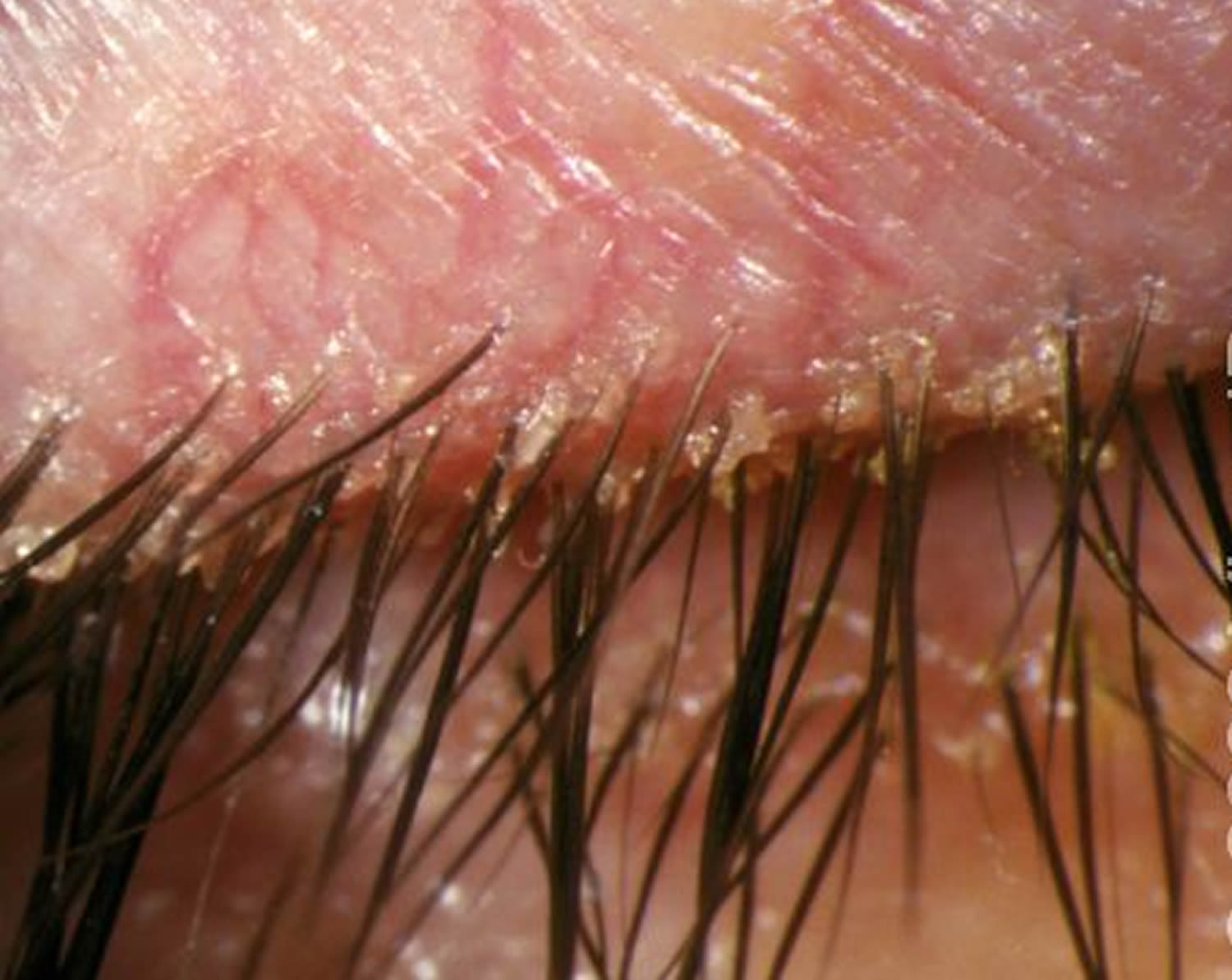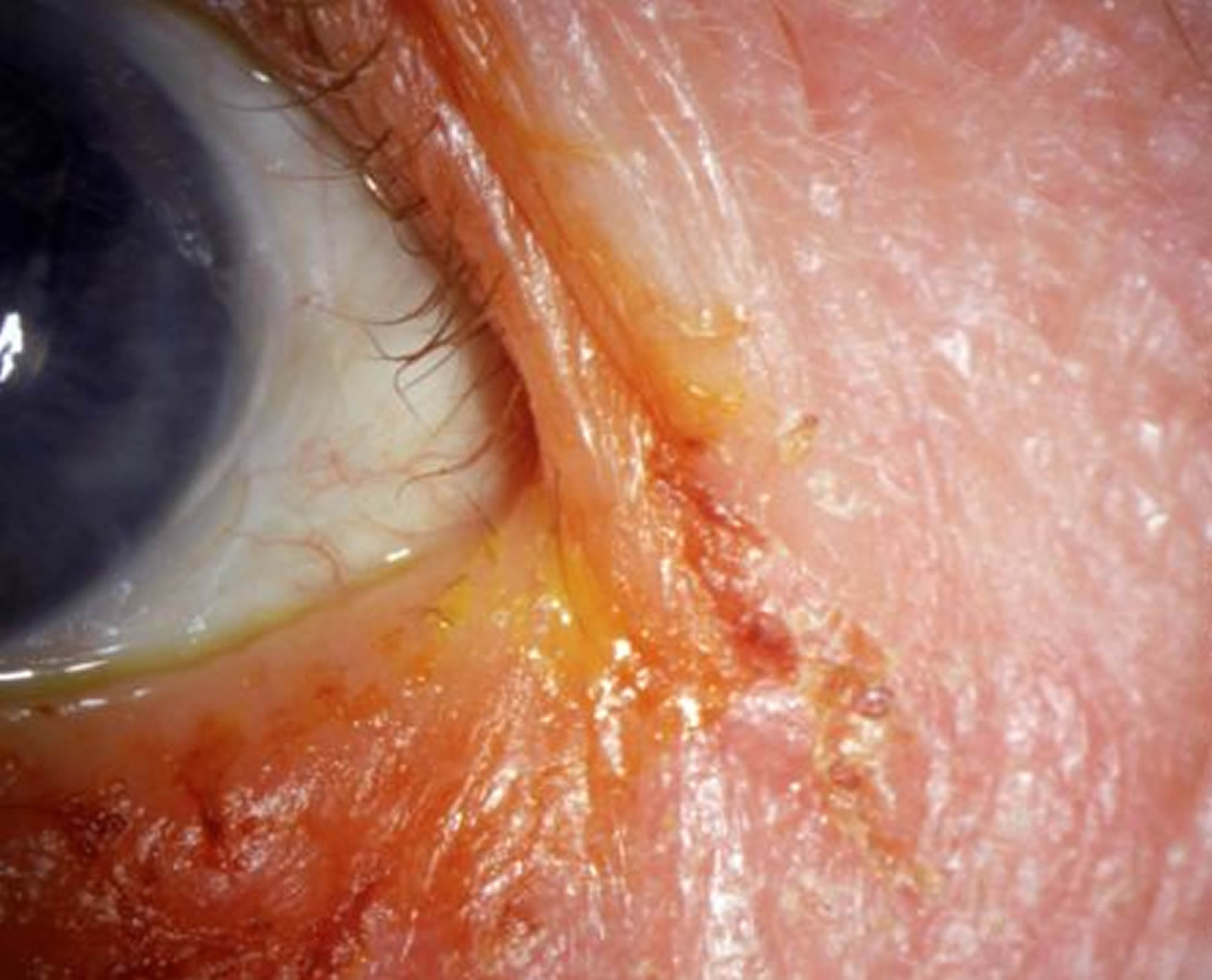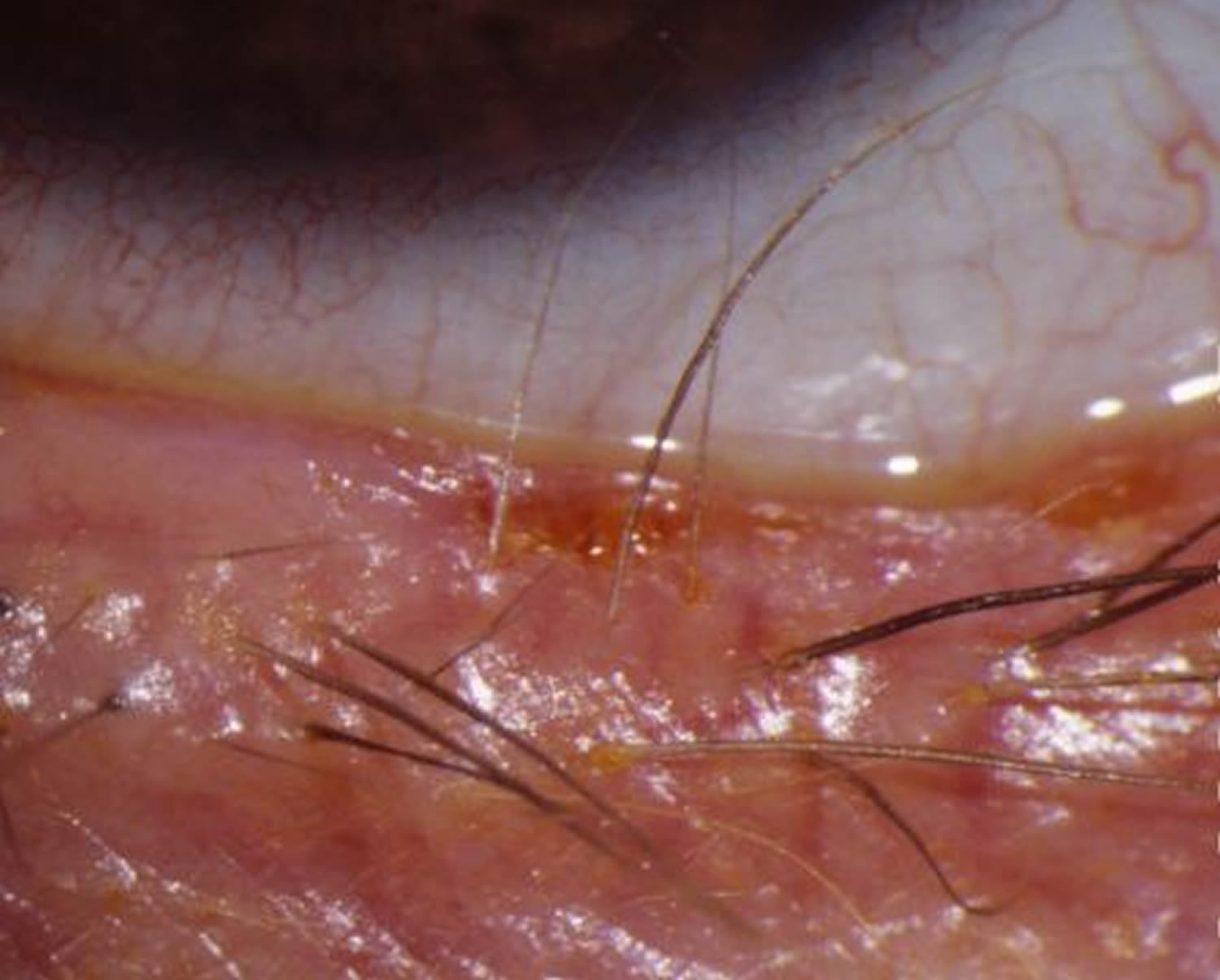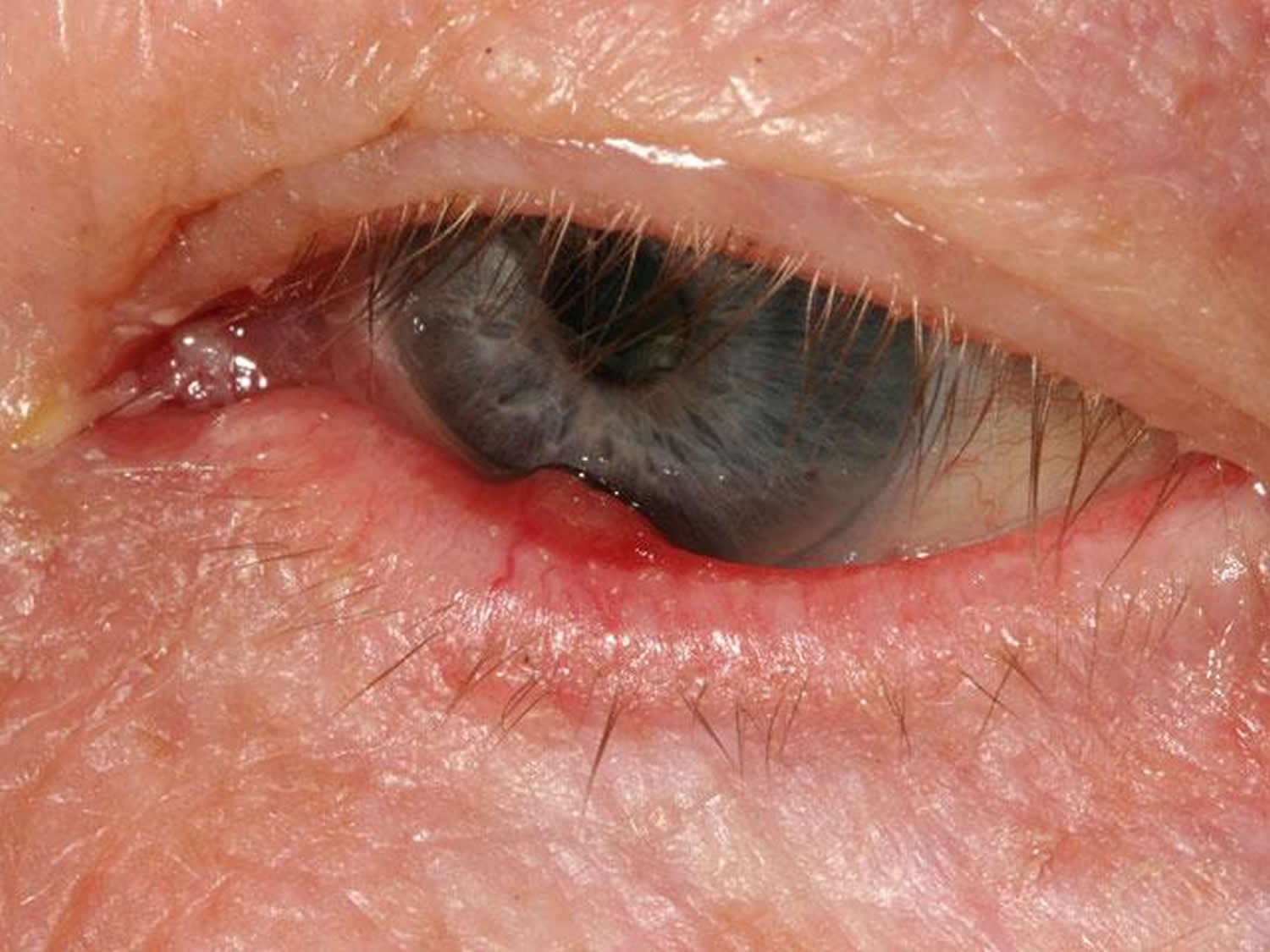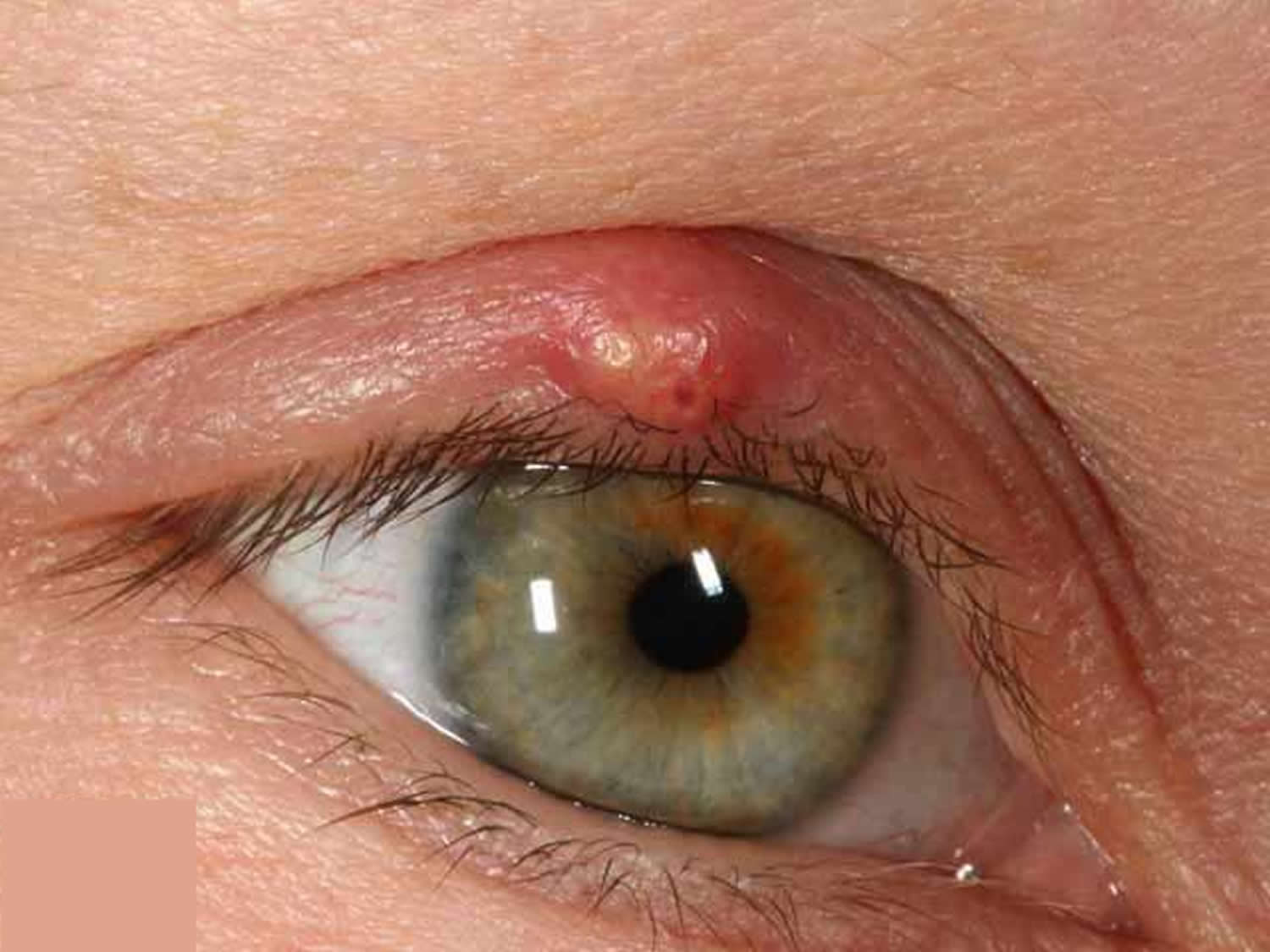Contents
What is blepharitis
Blepharitis is inflammation (pain, heat and swelling) of the edges of the eyelids (eyelid margins). Blepharitis usually affects both eyes. Although it feels uncomfortable, blepharitis does not cause loss of sight. Blepharitis tends to recur, but you can prevent it.
When blepharitis involves the outside front of the eyelid, where the eyelashes are attached, it is called anterior blepharitis.
Anterior blepharitis may be caused by:
- Bacteria
- Scalp dandruff (seborrheic dermatitis)
- Allergy
- Psoriasis
If blepharitis involves the inner eyelid, it is called posterior blepharitis. Posterior blepharitis may be caused by:
- Dysfunction of the oil (meibomian) glands in the eyelid
- Acne rosacea
- Scalp dandruff (seborrheic dermatitis)
- Allergy
The most common cause of blepharitis is a bacterial infection. The infection can be at the base of the eyelashes or in the glands of the eyelids.
Other causes include:
- blocked oil glands at the edge of the eyelids
- allergic reactions to eye drops
- skin complaints such as dandruff or Rosacea (skin redness).
If you have blepharitis, you might:
- feel that something is in your eye
- have itchy or burning eyes and eyelids
- find the edge of your eyelids are red
- have watery eyes
- be sensitive to light
- have crusty or sticky eyelashes, especially in the morning.
To stop blepharitis from coming back, keep your eyelids clean. Don’t use cosmetics around your eye.
Figure 1. Blepharitis – the crusty, grainy, or scaly appearance at the base of the eyelashes is the most common finding in blepharitis.
Figure 2. Angular blepharitis – the classic appearance of blepharitis involving the outer angle of the eyelid
Figure 3. Chronic blepharitis can lead to misdirected eyelashes, misshapen eyelashes, and loss of eyelashes (trichiasis)
If your eyes do not get better after a few days of eye care, see your doctor.
- Pain is increasing.
- Vision is worsening.
- Swelling is increasing.
- The eyelids become hot to the touch.
- The condition is not getting better within a week despite self-care.
- There is blistering and/or rash on the eyelids.
- There is development of a lesion (bump or growth) on the eyelid that does not respond to the warm compresses.
Your doctor may check and treat you for related conditions such as dandruff and dry eye syndrome.
Who’s at risk of blepharitis?
Although blepharitis is very common, people who have scalp dandruff (seborrheic dermatitis), dry skin, acne rosacea, contact allergies, diabetes, poor hygiene, or those sensitive to chemical irritants or cosmetic makeup are much more likely to suffer from blepharitis.
- Blepharitis is not contagious.
Blepharitis complications
Blepharitis can cause many different problems, although serious complications are rare.
Some of the complications associated with blepharitis can potentially affect your vision, although your eyesight shouldn’t be permanently damaged if these problems are identified and treated quickly.
Some of the main complications of blepharitis are described below.
Dry eye syndrome
Dry eye syndrome is a common complication of blepharitis. It occurs when your eyes don’t make enough tears or your tears evaporate too quickly. This can lead to your eyes drying out and becoming inflamed, which can cause them to feel dry, gritty and sore.
Dry eye syndrome can be caused by the same skin conditions that can cause blepharitis, as these can also affect the quality of your tears. These include:
- Seborrheic dermatitis – a condition that causes your skin to become oily or flaky
- Rosacea – a condition that mainly affects the face
Speak to your high-street optometrist at an opticians if you have constantly dry eyes. They may recommend using eye drops containing “artificial tears”, often available from pharmacists without a prescription.
Conjunctivitis
Conjunctivitis is inflammation of the conjunctiva. This is the transparent membrane that covers the white part of the eyeball and the inner surfaces of the eyelids.
Conjunctivitis can occur when bacteria in the eyelid infect the eyes. The condition isn’t usually serious and shouldn’t affect your vision.
Most cases of conjunctivitis are mild and pass in one to two weeks without the need for treatment. However, you should contact your GP or an optometrist if you think you have conjunctivitis.
If you wear contact lenses, you should remove these and not wear them again until the conjunctivitis is better.
Antibiotic eye drops may be prescribed if your symptoms continue or you have repeated infections.
Meibomian cysts (Chalazion)
A Meibomian cyst (chalazion) is when there’s swelling on the inside of your eyelids. A cyst can develop if one of your Meibomian glands, which produce an oily substance that forms part of your tears, becomes inflamed as a result of blepharitis.
The cysts are normally painless, unless they get infected. In these cases you should see your doctor, as antibiotics may be needed. Applying a hot compress to the cyst should help reduce the swelling, although cysts often disappear by themselves.
If a cyst doesn’t disappear, it can be removed with a simple surgical procedure carried out under local anesthetic (painkilling medication).
Figure 4. Meibomian cyst (chalazion)
Figure 5. Upper and lower eyelid chalazia (multiple chalazion)
Styes (hordeolum)
A stye (hordeolum) is a painful swelling that produces pus and develops on the outside of your eyelid at the base of the eyelash (eyelash follicle). Styes are caused by a bacterial infection.
A mild stye can be treated by applying a warm compress – a cloth warmed with hot water – to the area.
See your doctor or an optometrist if you have a very painful stye that isn’t getting better. If this happens, the stye may need to be drained using a small needle.
Figure 6. Stye (hordeolum)
Damage to the cornea
In severe cases of blepharitis or cases that don’t respond very well to treatment, the redness and swelling (inflammation) can damage the surface of the cornea, the transparent layer at the front of the eye. This is called keratitis.
Sometimes the cornea can become vulnerable to ulceration and infection, which is a sight-threatening condition. This is frequently associated with severe pain.
It’s essential that you get immediate medical advice if you notice symptoms of keratitis, including:
- sudden eye pain
- sensitivity to light
- a worsening in vision
Contact your doctor or a local emergency eye care service immediately if you experience any of these symptoms.
Eyelash problems
Blepharitis can cause your eyelashes to fall out or grow abnormally (misdirected eyelashes).
Eyelid skin problems
Scarring may occur on your eyelids in response to long-term blepharitis. Or the eyelid edges may turn inward or outward.
Excess tearing or dry eyes
Abnormal oily secretions and other debris shed from the eyelids, such as flaking associated with dandruff, can accumulate in your tear film — the water, oil and mucus solution that forms tears. Abnormal tear film interferes with the healthy lubrication of your eyelids. This can irritate your eyes and cause symptoms of dry eyes or excess tearing.
Difficulty wearing contact lenses
Because blepharitis can affect the amount of lubrication in your eyes, wearing contact lenses may be uncomfortable.
Blepharitis causes
The exact cause of blepharitis isn’t clear. It may be associated with one or more factors, including:
- Seborrheic dermatitis — dandruff of the scalp and eyebrows
- A bacterial infection
- Clogged or malfunctioning oil glands in your eyelids
- Rosacea — a skin condition characterized by facial redness
- Allergies, including allergic reactions to eye medications, contact lens solutions or eye makeup
- Eyelash mites or lice
Blepharitis occurs in two forms:
Anterior blepharitis
Anterior blepharitis affects the outside front of the eyelid, where the eyelashes are attached. The two most common causes of anterior blepharitis are bacteria (Staphylococcus) and scalp dandruff. Atopic dermatitis, seborrhoeic dermatitis and psoriasis affecting the eyelid may also result in blepharitis.
- Staphylococcal infection: the base of the eyelash is often colonized by the bacteria
- Seborrheic dermatitis / dandruff: the eyelid may also be colonized by yeasts (malassezia)
- Ocular rosacea: rosacea is an inflammatory disorder resulting in flushing, facial redness and spots
- Infestation of the eyelash by Demodex mite (demodicosis)
- Contact allergy to substances coming into direct contact with the lid margins, including rosin in mascara and preservatives in contact lens solutions.
Posterior blepharitis
Posterior blepharitis affects the inner eyelid (the moist part that makes contact with the eye) and is caused by problems with the oil (meibomian) glands in this part of the eyelid. Two skin disorders can cause this form of blepharitis: acne rosacea, which leads to red and inflamed skin, and scalp dandruff (seborrheic dermatitis).
Blepharitis symptoms
Blepharitis can develop at any age, and symptoms can include:
- itchy, sore and red eyelids that stick together
- crusty or greasy eyelashes or eyelids
- flaking skin around the eyes resulting in matting of the lashes
- scales may cling to the lashes
- frothy tear formation
- a burning, gritty sensation in your eyes
- increased sensitivity to light (photophobia)
- swollen eyelid margins
- finding contact lenses uncomfortable to wear
- abnormal eyelash growth or loss of eyelashes in severe cases
In most cases both eyes are affected, but one eye can be more affected than the other. The symptoms tend to be worse in the morning.
Blepharitis treatment
Blepharitis is usually a long-term condition. Most people experience repeated episodes, separated by periods without symptoms.
Blepharitis can’t usually be cured, but a daily eyelid-cleaning routine (good eyelid hygiene) can help control the symptoms, keeping the lids free of crusts and prevent permanent scarring of the eyelid margins.
When scalp dandruff is present, a dandruff shampoo for the hair is recommended as well. In addition to the warm compresses, patients with posterior blepharitis will need to massage their eyelids to clean the oil accumulated in the glands. Patients who also have acne rosacea should have that condition treated at the same time.
There are three main steps to eyelid hygiene that should be performed once or twice a day:
- Using a warm compress – to make the oil produced by the glands around your eyes more runny. Use warm compresses for 5 to 10 minutes a few times a day
- Gently massaging your eyelids – to push the oils out of the glands
- Cleaning your eyelids with a mixture of water and baby shampoo, dilute baby shampoo (2 drops in 1/2 cup of boiled water that’s been cooled)– to wipe away any excess oil and remove any crusts, bacteria, dust or grime that might have built up. Eyelid cleaners are available as a foam, cotton swab, liquid or wipe. Ask your pharmacist for more information.
Because blepharitis rarely goes away completely, most patients must maintain an eyelid hygiene routine for life. If the blepharitis is severe, an eye care professional may also prescribe antibiotics either applied to the eye or eyelid directly, or taken as tablets or steroid eyedrops.
Antibiotic drops and ointments
If you have blepharitis that doesn’t respond to regular cleaning, you may be prescribed a course of antibiotic ointments, creams or eye drops (topical antibiotics). You’ll usually need to use these for around four to six weeks.
Antibiotics applied to the eyelid have been shown to provide relief of symptoms and resolve bacterial infection of the eyelids. These are available in a variety of forms, including eyedrops, creams and ointments. If you don’t respond to topical antibiotics, your doctor may suggest an oral antibiotic.
Ointments and creams should be rubbed gently on to the edge of your eyelids, usually several times a day at first, using either clean fingers or a cotton bud.
Once your condition begins to improve, you may only need to do this once a day, usually at night after cleaning your eyelids using the method outlined above.
Cautions
You should avoid wearing contact lenses when using antibiotic eye drops, as the drops may build up behind the lenses and irritate your eye.
If you’re using more than one type of eye drop at the same time of day, leave at least five minutes before applying the second type of drops.
Let your doctor or optometrist know if you have continual irritation as they may recommend lubricant treatments.
You may experience some mild stinging or burning when applying antibiotic ointment or drops, but this should pass quickly. Don’t drive if the ointment blurs your vision.
Oral antibiotics
Low doses of antibiotics can be used as anti-inflammatory agents for a minimum of three to four months, or sometimes much longer.
You may be prescribed antibiotics to take by mouth once or twice a day if your blepharitis doesn’t respond to other treatments.
Oral antibiotics may also be recommended at the start of your treatment if it’s thought rosacea is aggravating your symptoms.
Most people respond well within the first few weeks of treatment, although you may need to take them for up to three months. It’s important for you to finish the course of antibiotics, even if your symptoms get better.
Cautions
Some oral antibiotics used to treat blepharitis have been known to make people more sensitive to the effects of the sun. While you’re taking them, you should avoid prolonged exposure to sunlight and using sun lamps or sunbeds.
Oral antibiotics can also sometimes affect unborn and developing babies, so they’re not normally used to treat women who are pregnant or breastfeeding. Certain types of antibiotics are avoided in children under 12.
Side effects of oral antibiotics are rare because the dose is very low. However, you should be aware of stomach upsets, vomiting or diarrhea.
Treating other conditions
If you have an underlying medical condition that’s causing blepharitis, your doctor will prescribe treatment for it or refer you to an appropriate specialist to ensure the condition is treated effectively.
Depending on the suspected cause of your condition and any other symptoms you have, you may also need additional treatment.
For example, if you have seborrheic dermatitis or dandruff, you may need to use an anti-dandruff shampoo on your scalp and eyebrows.
If you have dry eye syndrome, which frequently occurs alongside blepharitis, you may need separate treatment for this, such as “artificial tear” eye drops.
Medications to control inflammation
Steroid eyedrops or ointments may help control inflammation. Your doctor may prescribe both antibiotic and anti-inflammatory drugs.
Medications that affect the immune system
Topical cyclosporine (Restasis) is a calcineurin inhibitor that has been shown to offer relief of some signs and symptoms of blepharitis.
Blepharitis home remedies
Eyelid hygiene
It’s important to clean your eyelids every day if you have blepharitis, even if you’re using medication or don’t currently have any symptoms.
Good eyelid hygiene can help ease your symptoms and prevent it happening again.
Follow the steps below to keep your eyelids clean.
Warm compresses
- boil water and leave it to cool to a warm temperature
- soak a clean flannel or eye pad in the water and gently place this over the eyes for around 10 minutes
- make sure the flannel doesn’t get cold by reheating it in the warm water
You can also buy a special microwaveable compress for your eyes to use instead of a flannel.
Eye lid massage
- gently massage your closed eyes by rolling your little finger in a circular motion
- take a cotton wool bud and, with your eyes shut, gently roll it downwards on the upper eyelid towards the lashes and edges of the eyelids – this helps to push the melted oil out of the glands, but you won’t be able to see the tiny droplets
- repeat this process along the whole width of the upper and lower eyelids
This process may slightly irritate your eyes at first, a bit like getting soap in your eyes. However, this is normal and should get better with time.
Lid margin hygiene
Various eyelid-cleaning solutions and eyelid wipes are available commercially, or you can try making one at home.
For a home-made solution, fill a bowl with one pint of boiled water and allow it to cool to a warm temperature. Add a teaspoon of bicarbonate of soda.
Once you’ve made a cleaning solution:
- soak some clean cotton wool in the solution and remove crustiness from around the eyelids, paying special attention to the eyelashes
- repeat this process if necessary using a clean piece of cotton wool
- dip a clean cotton bud into the solution and gently clean the edges of the eyelids by wiping the cotton bud along the bases and lengths of the lashes
Your doctor, pharmacist or optometrist can advise you about suitable cleaning solutions, although you may need to try more than one product to find one that suits you.
It’s important to continue lid margin hygiene two or three times a week, even if you don’t have symptoms. This helps to prevent permanent scarring of the eyelid margins.
Don’t wear your contact lenses until the swelling goes down.
Oily tear eye drops
Oily tear drops are particularly useful if your blepharitis is causing quick evaporation of tears.
Eye drops that replace the oily part of the tear film and reduce evaporation from the surface of the eye are increasingly being used. These preparations include synthetic guar gums or liposomal sprays.
Liposomal sprays are over-the-counter medications that aren’t available on prescription. They’re sprayed on to the edges of your eyelids when your eyes are closed. When you open your eyes, the solution spreads across the surface of the eye, creating a new oily film.
Control dandruff and mites
If you have dandruff that’s contributing to your blepharitis, ask your doctor to recommend a dandruff shampoo. Using a dandruff-controlling shampoo may relieve your blepharitis signs and symptoms. Using tea tree shampoo on your eyelids each day may help deal with mites. Or try gently scrubbing your lids once a week with a 50 percent tea tree oil, which is available over-the-counter.
Diet
There’s some evidence to suggest a diet high in omega-3 fats can help improve blepharitis associated with rosacea.
The best sources of omega-3s are oily fish, such as:
- mackerel
- salmon
- sardines
- herring
- fresh or frozen tuna – not canned, as the canning process sometimes removes the beneficial oils
Aim to eat at least two portions of fish a week, one of which should be oily fish.
You can also get omega-3s from various nuts and seeds, vegetable oils, soya and soya products, and green leafy vegetables.
Omega 7 or sea buckthorn oil has also been found to be helpful.
